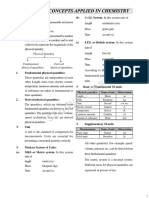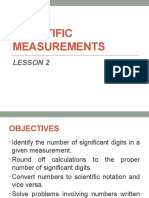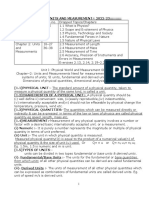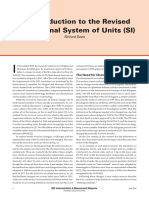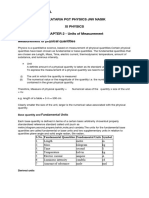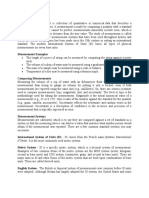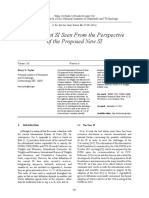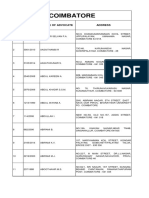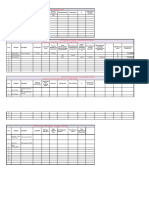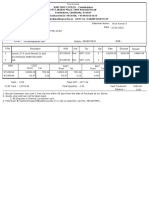0 ratings0% found this document useful (0 votes)
106 views12 pagesUnit of Measurement
Uploaded by
visvanthCopyright
© © All Rights Reserved
We take content rights seriously. If you suspect this is your content, claim it here.
Available Formats
Download as PDF or read online on Scribd
0 ratings0% found this document useful (0 votes)
106 views12 pagesUnit of Measurement
Uploaded by
visvanthCopyright
© © All Rights Reserved
We take content rights seriously. If you suspect this is your content, claim it here.
Available Formats
Download as PDF or read online on Scribd
You are on page 1/ 12
Ll
12
13
14
1s
16
Introduction
‘The international system of
units
Significant figures
Dimensions of physical
quantities
Dimensional formulae and
dimensional equations
Dimensional analysis and its
applications:
‘Summary
Exercises
1.1 INTRODUCTION
Measurement of any physical quantity involves comparison
with a certain basic, arbitrarily chosen, internationally
accepted reference standard called unit. The result of a
measurement of a physical quantity is expressed by a
number (or numerical measure) accompanied by a unit.
Although the number of physical quantities appears to be
very large, we need only a limited number of units for
expressing all the physical quantities, since they are inter-
related with one another. The units for the fundamental or
base quantities are called fundamental or base units. The
units of all other physical quantities can be expressed as
‘combinations of the base units. Such units obtained for the
derived quantities are called derived units. A complete set
of these units, both the base units and derived units, is
known as the system of units.
1,2 THE INTERNATIONAL SYSTEM OF UNITS
In earlier time scientists of different countries were using
different systems of units for measurement. Three such
systems, the CGS, the FPS (or British) system and the MKS.
system were in use extensively till recently.
‘The base units for length, mass and time in these systems
were as follows
* In CGS system they were
respectively,
+ In FPS system they were foot, pound and second
respectively.
+ In MKS system they were metre, kilogram and second
respectively.
‘The system of units which {s at present internationally
accepted for measurement is the Systéme Internationale
d’ Unites (French for International System of Units).
abbreviated as SI. The SI, with standard scheme of symbols,
units and abbreviations, developed by the Bureau
International des Poids et’ measures (The International
Bureau of Weights and Measures, BIPM) in 1971 were
recently revised by the General Conference on Weights and
Measures in November 2018. The scheme is now for
entimetre, gram and second
Rationalsed-2023-24
international usage in scientific, technical, industrial
and commercial work. Because SI units used decimal
system, conversions within the system are quite simple
and convenient. We shall follow the SI units in
this book. °
In SI, there are seven base units as given in
Table 1.1. Besides the seven base units, there are two
more units that are defined for (a) plane angle das the
re re ran aN
atio of length of are ds to the radius rand (b) solid «<<
angle d® as the ratio of the intercepted area dA of the
spherical surface, described about the apex O as the
centre, to the square of its radius r, as shown in
Fig. 1.1(@) and (b) respectively. The unit for plane angle
is radian with the symbol rad and the unit for the solid
angle is steradian with the symbol sr. Both these are !-!
dimensionless quantities.
0 = ds/7 radian,
fa)
—
4a=4A/? steradian
&)
Description of a) plane angle dB.and
(@) solid angie dQ
Table 1.1 SI Base Quantities and Units*
ymbol Defi
‘m The metre, symbol m. is the SI unit of length. It is defined by taking the
fixed numerical value of the speed of light in vacuum c to be 299792458,
‘when expressed in the unit m s, where the second is defined in terms of
the caesium frequency Aves.
Mass Kilogram kg_—_The kllogram, symbol kg. 1s the SI unit of mass. It is defined by taking the
‘Time second
Electric ampere
‘Thermo kelvin
dynamic
‘Temperature
Amountof mole
substance
fixed numerical value of the Planck constant frto be 6.62607015 10°twhen
‘expressed in the unit J s, which is equal to kg m?s", where the metre and
te second are defined in terms of e and Aves.
‘The second, symbols, Is the SI unit of time. Itis defined by taking the fixed
‘numerical value ofthe caesium frequency Aves, the unperturbed ground-
state hyperfine transition frequency of the caestum-133 atom, to be
19192631770 when expressed in the unit Hz, which is equal to 5
OY The ampere, symbol A the SI unit of electric current. It defined by
taking the fixed numerical value of the elementary charge e to be
1,602176634 10- when expressed in the unit C, which is equal to As,
‘where the second js defined in terms of Aves.
K ‘The kelvin, symbol K, is the SI unit of thermodynamic temperature,
Itis defined by taking the fixed numerical value of the Boltzmann constant
tobe 1.380649 10% when expressed in the unit J K", which is equal to
kgm*sk', where the kilogram, metre and second are defined in terms of
4h, cand Aves.
‘The mole, symbol mol, is the SI unit of amount of substance. One mole:
‘fixed numerical value of the Avogadro constant, NV,. when expressed in the
‘unit mot" and is called the Avogacro number. The amount of substance,
symbol n, of a system is a measure of the number of specified elementary
entities. An elementary entity may be an atom, a molecule, an ion, an electron,
any other particle or specified group of particles.
sal
5 ‘contains exactly 6.02214076 10% elementary entities, This number is the
ed Thecandela, symbol cd, is the St unit of uminous intensity in given direction,
It is defined by taking the fixed numerical value of the luminous efficacy of |
‘monochromatic radiation of frequency 540 10 Hz, K.,. tobe 683 when expressed
in the unit Im W2, which ts equal io od sr W2, or ed sr kg-'m?s*, where the
‘logram, metre and second are defined in terms of f, cand AVES.
©The values mentioned here need not be remembered orasked in a test. They are given here only to indicate the
extent ofaccuracy to which they are measured. With progress in technology, the measuring techniques get
improved leading to measurements with greater precision. The definitions of base units are revised to keep up
with this progress.
Rationalsed-2023-24
UNITS AND MEASUREMENT
‘Table 1.2 Some units retained for general use (Though outside SI)
‘Symbol
hectare
standard atmospheric pressure
Note that when mole is used, the elementary
entities must be specified. “These entities
may be atoms, molecules. ions, electrons,
other particles or specified groups of such
particles.
‘We employ units for some phystcal quantities:
that can be derived from the seven base units
(Appendix A 6). Some derived units in terms of
the SI base units are given in (Appendix A 6.1).
Some SI derived units are given special names
(Appendix A 6.2.) and some derived Stunits make
use of these units with special names and the
seven base units (Appendix A 6.3). These are
given in Appendix A 6.2 and A 6.3 for your ready
reference. Other units retained for general use
are given in Table 1.2.
‘Common SI prefixes and symbols for multiples
and sub-multiples are given in Appendix A2.
General guidelines for using symbols for physical
quantities, chemical elements and nuclides are
given in Appendix A7 and those for SI units and
some other units are given in Appendix AS for
your guidance and ready reference.
1.3. SIGNIFICANT FIGURES
As discussed above, every measurement
involves Thus, the result of
measurement should be reported in a way that
indicates the precision of measurement.
Normally, the reported result of measurement
is a number that includes all digits in the
number that are known reliably plus the first
digit that is uncertain. The reliable digits plus
Sores
3.7 x10" 8"
2.58 x 107 C/kg
h
a
~
ri
t
bar
a
R
4
>
ha
atm
101925 Pa = 1.013 « 10° Pa
the first uncertain digit are known as
significant digits or significant figures. If we
say the period of oscillation of a simple
pendulum is 1.62 s, the digits 1 and 6 are
reliable and certain, while the digit 2 is
uncertain. Thus, the measured value has three
significant figures. The length of an object
reported after measurement to be 287.5 em has
four significant figures, the digits 2. 8, 7 are
certain while the digit 5 is uncertain. Clearly,
reporting the result of measurement that
includes more digits than the significant digits
is superfluous and also misleading since it
would give a wrong idea about the precision of
measurement,
The rules for determining the number of
significant figures can be understood from the
following examples. Significant figures
indicate, as already mentioned, the precision
of measurement which depends on the least
count of the measuring instrument. A choice
of change of different units does not
change the number of significant digits or
figures in a measurement. This important
remark makes most of the following
observations clear:
(1) For example, the length 2.308 em has four
significant figures. But in different units, the
same value can be written as 0.02308 m or 23.08
mm or 23080 im.
All these numbers have the same number of
significant figures (digits 2, 3, 0, 8), namely four.
Rationalsed-2023-24
puysics
This shows that the location of decimal point is
of no consequence in determining the number
of significant figures.
The example gives the following rules
+ All the non-zero digits are significant.
+ Allthe zeros between two non-zero digits
are significant, no matter where the
decimal point is, if at all.
+ If the number is less than 1, the zero(s)
on the right of decimal point but to the
left of the first non-zero digit are not
significant. [In 0.00 2308, the underlined
zeroes are not significant}
+ The terminal or trailing zero(s) in a
number without a decimal point are not
significant.
[Thus 123 m= 12300 cm = 123000 mm has
three significant figures, the trailing zero(s)
being not significant.] However, you can also
see the next observation
+ The trailing zero(s) in a number with a
decimal point are significant.
[The numbers 3.500 or 0.06900 have four
significant figures each.]
(2) There can be some confusion regarding the
trailing zeros). Suppose a length is reported to
be 4.700 m. It is evident that the zeroes here
are meant to convey the precision of
measurement and are, therefore, significant. [If
these were not, it would be superfluous to write
them explicitly, the reported measurement
would have been simply 4.7 ml. Now suppose
we change units, then
4.700 m= 470.0 em = 4700 mm = 0.004700 km
Since the last number has trailing zerofs) in a
number with no decimal, we would conclude
erroneously from observation (1) above that the
number has two significant figures, while in
fact, it has four significant figures and a mere
change of units cannot change the number of
significant figures.
(3) To remove such ambiguities in
determining the number of significant
figures, the best way is to report every
measurement in scientific notation (in the
power of 10). In this notation, every number is
expressed as a x 10", where a is a number
between 1 and 10, and b is any positive or
negative exponent (or power) of 10. In order to
get an approximate idea of the number, we may
round off the number ato 1 (for @ <5) and to 10
(for 5
You might also like
- NCERT Class 11 Physics Part 1 Units and MeasurementNo ratings yetNCERT Class 11 Physics Part 1 Units and Measurement23 pages
- Some Basic Concepts Applied in ChemistryNo ratings yetSome Basic Concepts Applied in Chemistry7 pages
- Class 11 Physics PPT Chapter 1 Units-And-Measurement100% (1)Class 11 Physics PPT Chapter 1 Units-And-Measurement60 pages
- PHYSICS 1 - 1st Quarter Lessons ReviewerNo ratings yetPHYSICS 1 - 1st Quarter Lessons Reviewer9 pages
- An Introduction To The Revised International System of Units (SI)No ratings yetAn Introduction To The Revised International System of Units (SI)5 pages
- NOTES - XI - Units and Measurement - Docx-1No ratings yetNOTES - XI - Units and Measurement - Docx-18 pages
- Chapter 1 - Matter and Measurement (FCC0015)No ratings yetChapter 1 - Matter and Measurement (FCC0015)82 pages
- Viii-Chemistry (Foundation For IIT Aspirantes)No ratings yetViii-Chemistry (Foundation For IIT Aspirantes)130 pages
- Units and Measurements TP 1 Sol (The International System of Units and Significant Figures)No ratings yetUnits and Measurements TP 1 Sol (The International System of Units and Significant Figures)4 pages
- The Current SI Seen From The Perspective of The Proposed New SINo ratings yetThe Current SI Seen From The Perspective of The Proposed New SI11 pages
- C1 Physical Quantity Units Measurement - Teacher Ver Oct 31 2023No ratings yetC1 Physical Quantity Units Measurement - Teacher Ver Oct 31 202311 pages
- Cbu Zaf PH 110 Term 1-2 - November 2024No ratings yetCbu Zaf PH 110 Term 1-2 - November 2024363 pages
- Akayukthi Nature Cure Centre Residential Program BrochureNo ratings yetAkayukthi Nature Cure Centre Residential Program Brochure8 pages
- Neet 2017-2023 Physics Question Paper Chapter Wise Weightage ResearchNo ratings yetNeet 2017-2023 Physics Question Paper Chapter Wise Weightage Research1 page
- BVM / BVM Global at Karpagam Campus: BUS FORM 2021-2022No ratings yetBVM / BVM Global at Karpagam Campus: BUS FORM 2021-20221 page
- JUST BUY CYCLES - Coimbatore: Grand TotalNo ratings yetJUST BUY CYCLES - Coimbatore: Grand Total1 page











